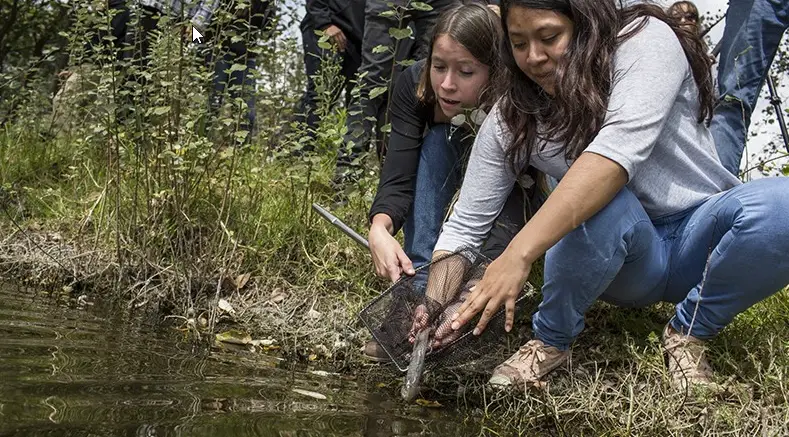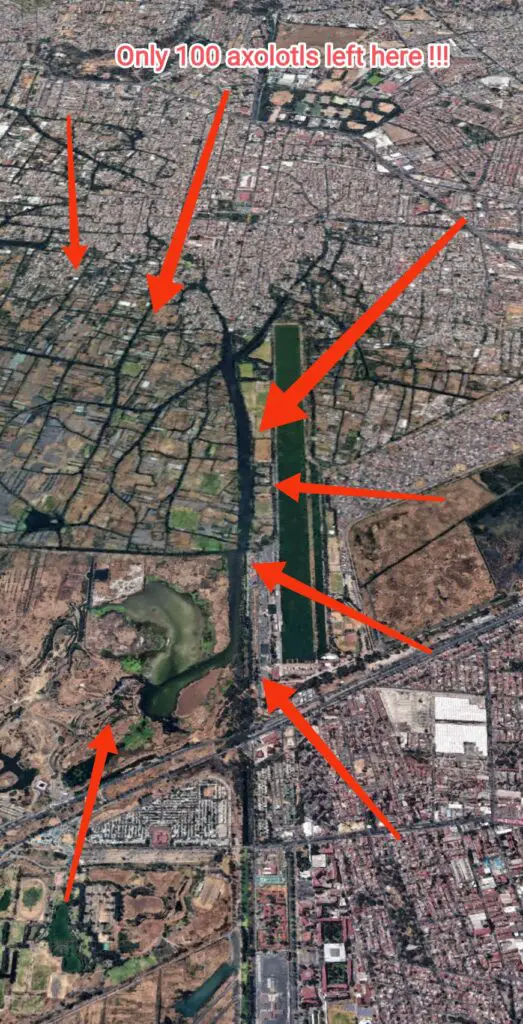Are axolotls endangered and why are they still?
Despite their large numbers in captivity, the efforts of the Mexican government and some associations to save wild axolotls, Ambystoma mexicanum is still classified by the International Union for Conservation of Nature (IUCN) as a Critically Endangered species because of the rapid decline of their population in their natural habitat, which unfortunately is also shrinking.

How many wild Axolotl are left in the world ?
According to specialists who monitor the evolution of the number of axolotls in the few inland rivers near Lake Xochimilco, their number will not exceed 1000 adult individuals and may disappear completely in their natural habitat after 2025, almost 19 years after the axolotls were declared endangered (in 2006)!
It should not be forgotten that in the 80’s, an average of 20 tons of axolotls were fished each year by the local inhabitants.
Unfortunately, Dr. Virginia Graue only counted an average of 6000 axolotls per square kilometer in 1998 and since that year, the number of mature axolotls has been decreasing.
There were only 1000 axolotls per square kilometer in 2004, and Dr. Luis Zambrano (director of the Reserva Ecológica del Pedregal of the UNAM) had as for him, counted only 100 axolotl per square kilometer in 2008 and in 2014, their number had still decreased to 36 axolotls per square kilometer which is very worrying!
In 2015, some scientists even believed that the axolotls had completely disappeared, fortunately, they found a few weeks later, a few individuals!
Dr Zambrano ” It is more effective to create sanctuaries in which the existing axolotls can survive and perhaps thrive”.
There are probably several thousand, even hundreds of thousands of axolotls either as pets or in research laboratories on the regeneration of human tissues, but in the wild, axolotls struggle to survive and are threatened with extinction at any moment.
What is being done to save wild axolotls from extinction?
1- Civilian environmental organizations, including Umbral Axiochatl, as well as some Mexico City officials, have set up a rescue program for axolotls, in the hope of gradually releasing them into their natural environment. A few hundred axolotls are being cared for in facilities such as those in the Chapultepec Forest and in the CDMX Zoo.
2 – Refuges were established for the axolotls in the wetlands of Xochimilco, involving the local population, the chinampas, in this effort to at least try to halt the vertiginous decline of their population.



3- The efforts made by the Institute of Biology of the UNAM and its researcher Luis Zambrano González in considering other natural environments to create temporary habitats for axolotls, such as in the interior of Ciudad Universitaria (CU) which are semi-natural lakes in and the lakes of Cantera Oriente (in the Reserva Ecológica del Pedregal de San Ángel), while waiting for the restoration of their natural habitat, the one of Xochimilco, where they will be able to proliferate again.
4- Efforts to combat invasive species of fish such as carp and African tilapia, introduced by fishermen into these lakes, which are among the causes of the decline in the number of axolotls, because these fish attack the eggs of the axolotls, chase the baby axolotls, and above all, have almost the same diet, which leaves the axolotls with almost no food, and this has been reflected in the frequency of their reproduction, their size once they are adults, and other problems.
5- The installation of radio transmitters on some axolotls to follow their movements in order to establish the best way to introduce them in their natural environment, this work is done by Ciudad Universitaria (CU).
6- Raising awareness among the inhabitants of the Xochimilco lake area about the threat to the axolotls and the need to protect them and not to pollute the lake, as well as raising awareness about certain practices, because some people consider axolotls to be exotic food, others hunt them for their medicinal virtues against coughs and asthma, while others hunt them just to sell them to tourists…
7- The collaboration between the researchers of Michoacan University and the Sisters of Immaculate Health of the monastery in the central Mexican town of Patzcuaro (these nuns, like Sister Ofelia Morales Francisco, have an experience of 30 years on axolotls) to work on the reintroduction of axolotls in their natural environment.
These nuns have taken care of the wild axolotls that they have been raising in tanks for several generations, these nuns make an ancient Mexican remedy, some Cough Syrup for respiratory illnesses, whose active principle comes directly from the “Achoques”, wild axolotls that only lives in nearby Lake Patzcuaro and this without hurting or mutilating them of course.
The goal of the scientists is to take advantage of the knowledge of these nuns on the axolotls, their axolotl-breeding talents and especially to try to make reproduce individuals resulting from this monastery because they are more apt genetically to behave well and to resist well when they will be reintroduced in their natural or semi-natural medium.
We must thank Dr. Gerardo Garcia and Dr. Erika Servin Zamora for the care offered to the axolotls of the Monastery and the technical support they offer to the nuns and the UK’s Chester Zoo for the Conservation breeding program and the creation of some axolotls refuges as well as the funding of this project, because the main goal of this collaboration is breeding these “Achoques” wild axolotls and release them in their natural habitat to avoid their total disappearance while waiting for wider measures to be taken to help them.
Why did the axolotls almost disappear so quickly?
The main cause of the decrease in the number of axolotls are humans, here are the main reasons:
Firstly, the Spanish Conquistadors dried up the lakes where the axolotls live and proliferate, which reduced the surface of their natural habitat, but above all, this always causes a problem of flooding during the rainy season and drought during the dry season.
The local population has always fished axolotls for consumption as exotic fish.
The inhabitants of the area around Lake Xochimilco and the Patzcuaro region have always hunted axolotls for their “medicinal virtues”, which according to local belief cure respiratory diseases.
The expansion of Mexico city to the detriment of the habitat of the axolotls because of the constructions around the lakes and the urban pollution generated by this practice. Not to mention the pollution of the water of these lakes, which has become alkaline, salty and polluted because of the waste treatment systems that flood the canals of Xochimilco with ammonia and heavy metals every time there is a storm.
The intensive hunting of wild axolotls in order to sell them to foreign researchers (I accuse Lazzaro Spallanzani in 1768 for having noticed the regenerative capacity of axolotls, Alexander von Humboldt who sent two specimens to Paris in 1804 and who caused the expedition of 1863 and the French zoologist Auguste Duméril who had introduced axolotls in the laboratories without knowing that they do not exist anywhere else! )
American laboratories also still using some wild axolotls for their research in the field of regeneration of human tissues, all this because of the regenerative capacity of axolotls that can regenerate their limbs, their spine and even part of their heart, they study in fact the blastema, a group of cells that cover the wounds …
The introduction of fish species such as carp and tilapia by the United Nations (UN) in 1970 and 80’s (programs of the Food and Agriculture Organization of the UN) and some fishermen in these lakes for pleasure and economic reasons too, while these fish feed on baby axolotls, their eggs …
The appetite of some humans for endangered species, especially from Asian countries, which increases the price of wild axolotls, I speak of Japanese restaurants especially even if the majority of axolotls they consume are axolotls born in captivity, but these practices are to be denounced!
As if the climate change that has accelerated the proliferation of algae and other invasive species that modify the acidity and temperature of the water of the Xochimilco canals around Mexico City were not enough!
Humans living around what remains of the natural habitat of the axolotls, unlike the Aztecs (they created an elaborate canal system, axolotls were thriving there) who lived in total harmony with the revered axolotls, these inhabitants keep polluting the waterways.
The degradation of the Water quality by intensive agriculture around the lake Xochimilco which floods the region of pesticides and toxic products for the axolotls.
Why are axolotls more endangered than ever?
Axolotls, this emblem of Mexico City, are more than ever endangered for reasons, all related to human behavior despite the media hype, the project to dig a new canal to release axolotls born in captivity and the promise of farmers to stop using pesticides.
These are the different reasons why, in a short time, there will be no wild axolotl left in their last natural sanctuary, the canals of Lake Xochimilco:
The waters of this lake are continually polluted because of the intensive agriculture practiced around it, at Cerro de la Estrella, and the use of pesticides and chemical treatments that all end up in the lake.
The local residents also play a big role in the pollution of the lake by watering their floating gardens (chinampas) with fertilizers, which accentuates the pollution .
Almost all of the houses surrounding the lake dump their sewage into the lake when they should have been using septic tanks to avoid contaminating the lake, and they also use the lake as a dumping ground for their waste, especially old electronic devices that constantly release chemicals into the water.
Some tourists and boaters often rent boats for parties and dump all their waste into the lake and this irresponsible practice does not help the few efforts to save the axolotls.
Finally, the most responsible for the alarming decline in the number of wild axolotls in Lake Xochimilco is the Mexican government, which only pretends to want to save the axolotls and only proposes superficial measures because local officials are not really aware of the importance of axolotls and the need to save this species that fascinates so many people in the world.
Why is it difficult to relocate the axolotls to another lake?
Axolotls have very specific conditions for them to survive and thrive ; they need clean water, well defined and relatively cold and stable temperatures, a stable PH, they also need mud banks and some freshwater aquatic plants to deposit their eggs.
Axolotls need quietness because they are very sensitive to unnatural sounds, which stresses them and causes illness and even death.
Although Lake Xochimilco was declared a World Heritage Site by the United Nations Educational, Scientific and Cultural Organization (UNESCO) in 1987, unplanned urbanization around the lake has helped to destroy this unique axolotl habitat.
Can axolotls still be saved from extinction?
The report is still alarming because the axolotls (Ambystoma mexicanum) are on the brink of extinction, the main reason is clear, the immaturity of the human race and the indifference of the authorities and political leaders towards animal species especially when they do not generate direct economic profits! which is shameful!
It is not also the Bank of Mexico, Banxico which is going to create in 2022 a bill of 50 pesos with the image of the salamander and the corn! It is almost a joke!
What is the Mexican government doing to save the axolotl?
The Mexican government has listed this amphibian in the (special protection) category, but is in the process of upgrading this category to a higher risk category, so that the laws will protect it more, although it is already listed in Appendix II of CITES.
But the bureaucracy that prevails there does not help the efforts to save axolotls, the administrations are usually changed just after three years of their installation which causes a discontinuity in the axolotl rescue programs.
Drawing axolotls on the walls of Mexico City, its election as the symbol of the city and even the 50 peso bill created in its effigy, will unfortunately not save the axolotls from extinction and only real conservation measures can do that.
We hope that the Mexican government will allocate more funds to save the axolotl from extinction and above all be more severe in the application of the laws that are supposed to protect the axolotl and their last natural habitat.
Final Thoughts
The first thing that saved the axolotls is that they became very rare and especially very difficult to catch, a kind of self-defense after the humans abandoned them!
Personally I thank all those who take care that this fabulous animal does not disappear from its natural environment.
Finally, all these efforts will remain vain and ineffective if the local population does not do anything to save the axolotls, it will be necessary to stop aggressing their natural habitat, to stop hunting them, to stop polluting their water…


